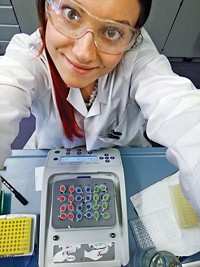Advertisement
Grab your lab coat. Let's get started
Welcome!
Welcome!
Create an account below to get 6 C&EN articles per month, receive newsletters and more - all free.
It seems this is your first time logging in online. Please enter the following information to continue.
As an ACS member you automatically get access to this site. All we need is few more details to create your reading experience.
Not you? Sign in with a different account.
Not you? Sign in with a different account.
ERROR 1
ERROR 1
ERROR 2
ERROR 2
ERROR 2
ERROR 2
ERROR 2
Password and Confirm password must match.
If you have an ACS member number, please enter it here so we can link this account to your membership. (optional)
ERROR 2
ACS values your privacy. By submitting your information, you are gaining access to C&EN and subscribing to our weekly newsletter. We use the information you provide to make your reading experience better, and we will never sell your data to third party members.
Environment
Newscripts
Is this real life, or is it just fantasy?
by Melissa Gilden
February 9, 2019
| A version of this story appeared in
Volume 97, Issue 6
An augmented proposal

Technology has transformed our romantic rituals, from dating online to sharing the perfect wedding photo on Instagram. And marriage proposals are no exception. Thomas Chan is an assistant professor of psychology at California State University, Northridge, whose research focuses on finding ways to use technology to combat cognitive diseases and enhance the well-being of patients. Chan had recently acquired the Magic Leap One Creator Edition for his work when he decided to integrate it into his marriage proposal to Carly Wade, a mental health therapist. Magic Leap One is an augmented-reality headset that superimposes 3-D computer-generated images over the wearer’s normal field of vision. Augmented reality allows wearers to remain in their environment, unlike virtual reality, which completely changes the landscape.
“I was basically the guinea pig,” Wade tells Newscripts. She says she didn’t have to be convinced to put on the headset that day. “I totally knew it was happening. He was nervous. He’s never nervous.”
Chan had programmed the headset to display an impressive gallery of photos of the couple, while their song, ODESZA’s “Corners of the Earth,” played in the background. Wade and Chan walked slowly, arm in arm, while Wade watched the chronological display on the headset. Eventually they arrived at a small table adorned with cute, frolicking computer-generated animals—and a very real engagement ring and bouquet of roses.
“He got down on one knee, and I was like, ‘Oh, is this real?’ ” Wade jokes.
With many of Chan’s students watching and filming, Wade said yes. The two will marry in Maryland in October, where they plan to have a space-themed wedding. The Newscripts gang wishes them the very best!

Bolivian amphibian seeks same
In fair Cochabamba, where we lay our scene, Romeo, a lone Bolivian Telmatobius yuracare (Sehuencas water frog), once thought to be the last of his kind, may have finally found his match.
This time last year, Global Wildlife Conservation (GWC), an environmental group, teamed up with Match.com, a dating website, and the Bolivian Amphibian Initiative to raise money to help Romeo the frog find his Juliet. For the 10 years that Romeo has been in captivity at the Natural History Museum in Cochabamba, Bolivia, conservation scientists sought a mate for him, to no avail.
“Romeo started to call for a mate about a year after he was brought into captivity, but those calls have slowed in the last few years. We don’t want him to lose hope,” Arturo Muñoz, founder of the Bolivian Amphibian Initiative and GWC associate conservation scientist, said last year in a press release. The campaign aimed to send 10 expeditions to locations where the species was once common. They even made Romeo a profile on Match.com.
Advertisement
Last month Teresa Camacho Badani, the museum’s chief of herpetology, announced that a whopping five frogs had been found in one of Bolivia’s cloud forests. Two of the frogs are females. One, whom the scientists have dubbed Juliet, is age appropriate for our Romeo.
Romeo, enveloped in crushing loneliness, does not yet know that a potential mate has been found. All five of the frogs have been quarantined at the museum, where they will acclimate to their new home and begin preventive treatment for chytridiomycosis, a fungal infection that affects amphibians like the T. yuracare. The team hopes to introduce Romeo and Juliet on Valentine’s Day.
Hopefully, for the sake of the perpetuation of their species, the two will have similar tastes in music and will not be annoyed by the sound of each other croaking.
Melissa Gilden wrote this week’s column. Please send comments and suggestions to newscripts@acs.org





Join the conversation
Contact the reporter
Submit a Letter to the Editor for publication
Engage with us on Twitter